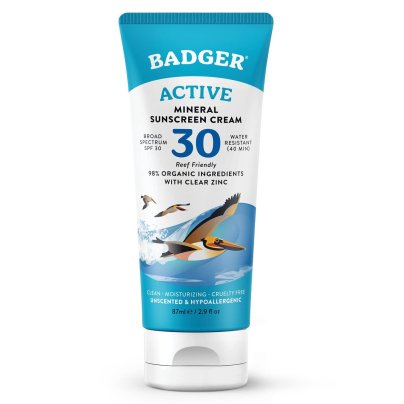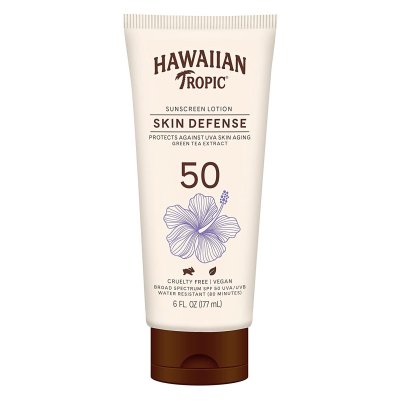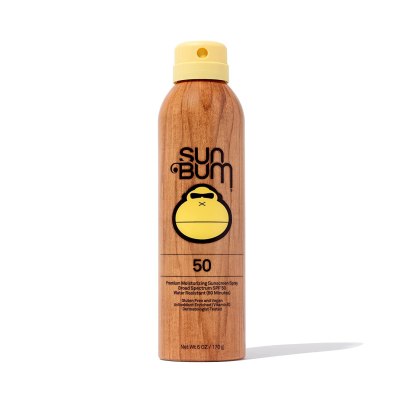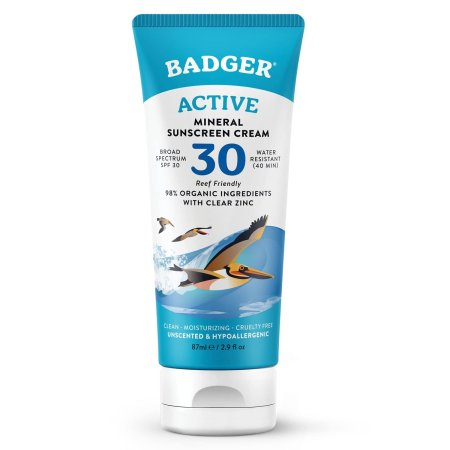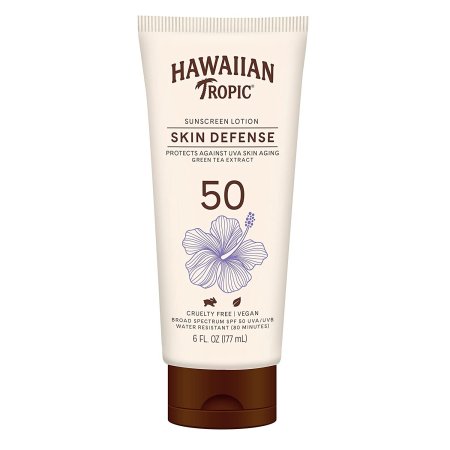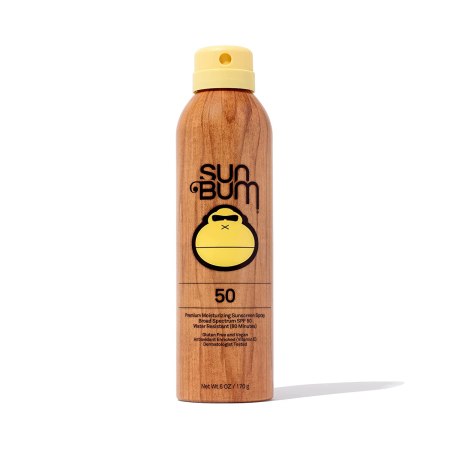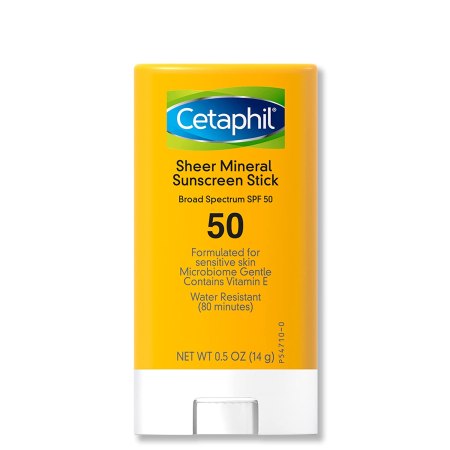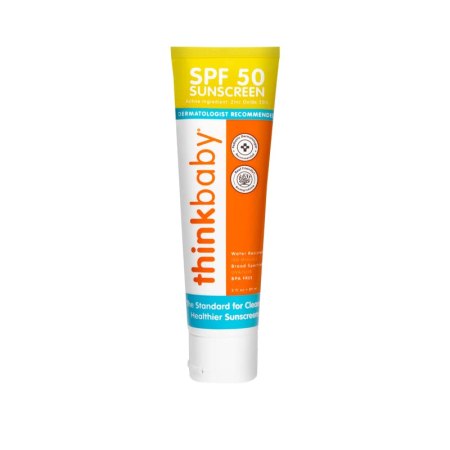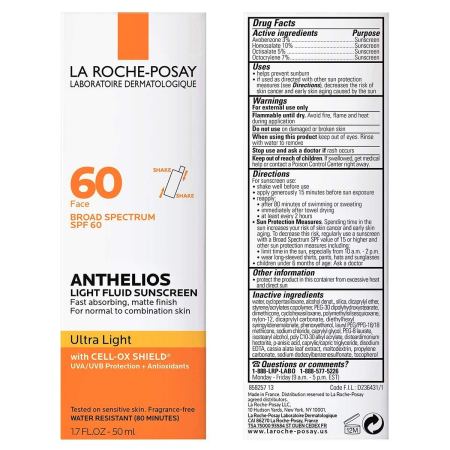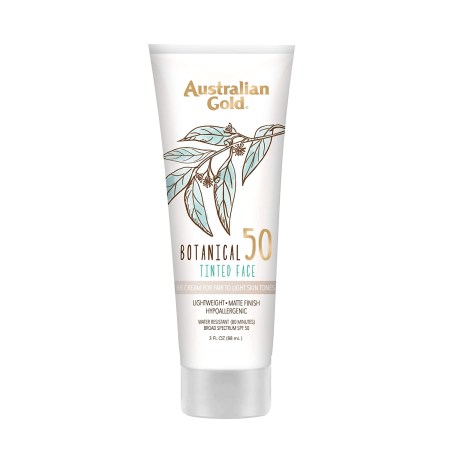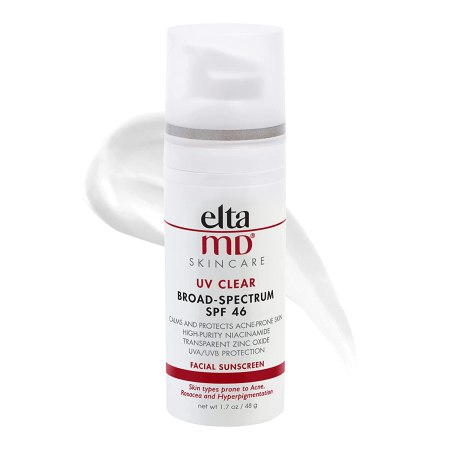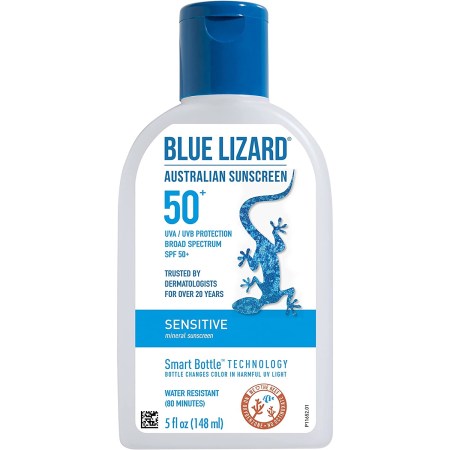We may earn revenue from the products available on this page and participate in affiliate programs. Learn More ›
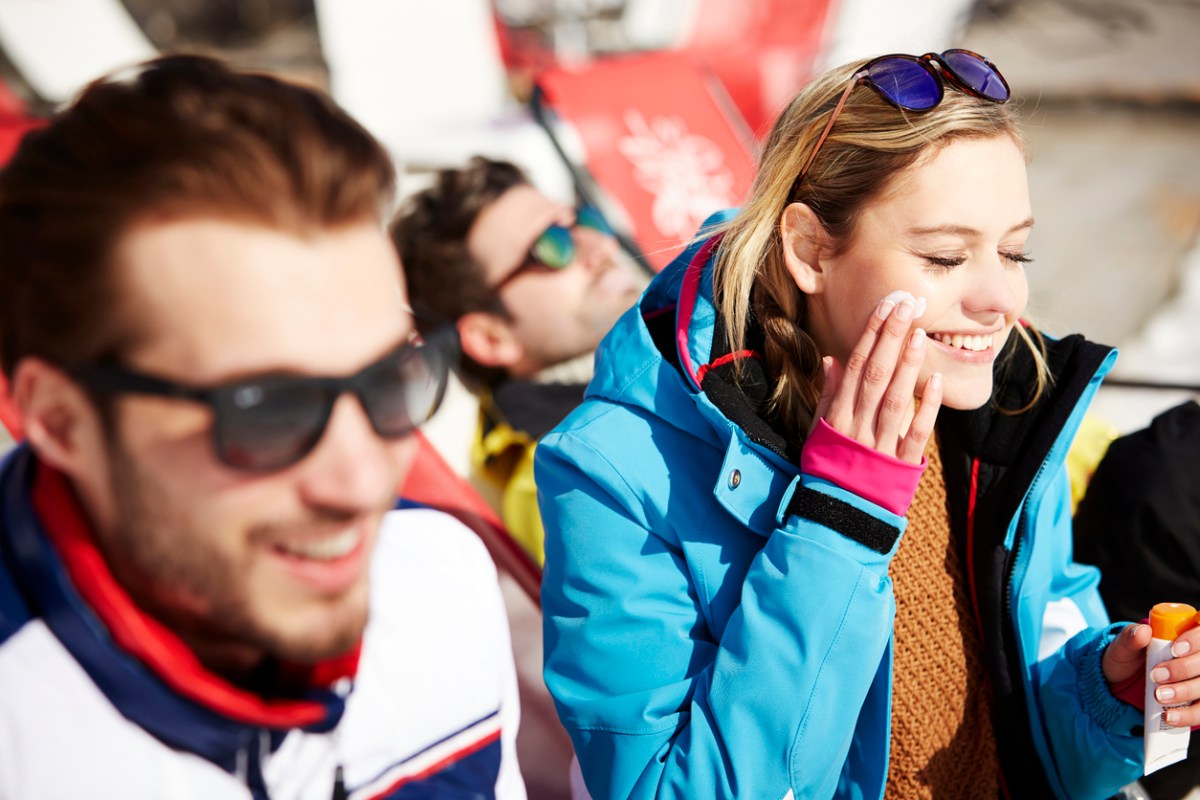
Using sunscreen daily provides an array of benefits, protecting skin from sunburn, sun damage, and, most important of all, skin cancer. In fact, the Skin Cancer Foundation recommends applying sunscreen every day (rain or shine) to take care of skin health. But sunscreen is by no means a one-type-fits-all product, which is why there are options for all sorts of application preferences and skin types, including water-resistant sprays for long days outdoors or moisturizing creams that wear well under makeup.
That said, there are a few features that all good sunscreens share: a high sun-protection factor (SPF), broad-spectrum protection, and a texture that doesn’t feel overly sticky or greasy. We’ve rounded up the best sunscreens ahead for year-round skin protection.
- BEST OVERALL: Badger SPF 30 Active Mineral Sunscreen Cream
- BEST BANG FOR THE BUCK: Hawaiian Tropic SPF 50 Skin Defense Lotion
- BEST SPRAY: Sun Bum SPF 50 Original Sunscreen Spray
- BEST STICK: Cetaphil SPF 50 Sheer Mineral Sunscreen Stick
- BEST FOR KIDS: Thinkbaby SPF 50 Safe Sunscreen
- BEST FOR FACE: La Roche-Posay SPF 60 Anthelios Facial Sunscreen
- BEST TINTED: Australian Gold SPF 50 Botanical Tinted Sunscreen
- BEST FOR ACNE-PRONE SKIN: EltaMD SPF 46 UV Clear Broad-Spectrum Sunscreen
- BEST FOR SENSITIVE SKIN: Blue Lizard SPF 50+ Sensitive Mineral Sunscreen
How We Chose the Best Sunscreens
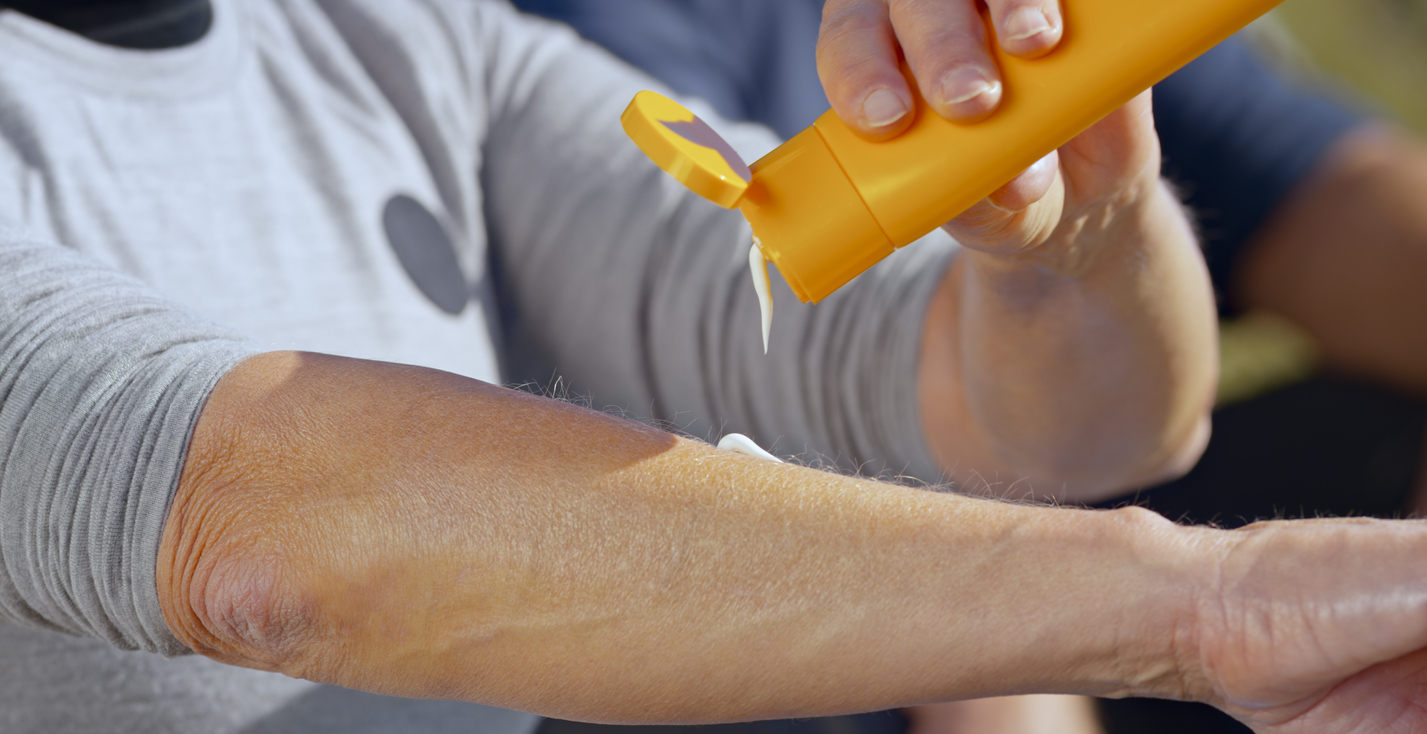
Sunscreen must have a high enough SPF to be protective, so we only included products with a SPF 30 rating and higher. We included a range of top-rated sunscreen types, from rugged sport formulas to those suited to delicate skin. Usage habits are just as important as protection level, and it’s important to wear sunscreen every day (or as often as possible). Therefore, we also considered ease of use, choosing the top sunscreens with different textures and application methods to make regular, frequent use simple and even pleasurable.
For many people, the greasy or sticky texture of sunscreen can turn them off from daily use. We prioritized comfort, checking the sunscreen formula and shopper reviews to find products that feel nice on the skin. We chose from popular sunscreen brands with good reputations for effective products.
There are also concerns about some chemical sunscreen ingredients that may negatively impact coral reefs. As often as possible, we chose reef-friendly products, which rely on minerals as opposed to chemical ingredients. In our sunscreen reviews, we flagged problematic ingredients that can damage reefs to make shoppers more aware.
Our Top Picks
A regular sun-protection routine should include a good sunscreen that’s protective, easy to apply, and nice to wear. Maintain healthier skin with the best sunscreens ahead.
Best Overall
Badger SPF 30 Active Mineral Sunscreen Cream
See ItThe Badger SPF 30 sunscreen cream is about as natural as it gets when it comes to sunscreen. It only contains five ingredients, which are 98 percent organic: zinc oxide, organic sunflower oil, organic beeswax, sunflower vitamin E, and organic sea buckthorn extract. However, since this product is made with zinc oxide, oil, and beeswax, it does have a thicker, oilier texture. This may be a benefit for dry skin, but it can make the product harder to apply and less pleasant to wear.
Even with so few ingredients, this sunscreen still offers impressive protection. It’s an SPF 30 broad-spectrum sunscreen and is water-resistant for up to 40 minutes. It’s also reef-friendly, cruelty-free, and unscented.
Product Specs
- SPF: 30
- Application: Cream
- Chemical or mineral: Mineral
Pros
- The very short and simple ingredient list appeals to those who prefer natural products
- It’s formulated with over 98 percent organic ingredients, and it’s fully reef-friendly
- Offers suitable SPF coverage and some water resistance, even with minimal ingredients
Cons
- Some users report disliking the thick and greasy texture
Get the Badger sunscreen at Amazon or Badger.
Best Bang For The Buck
Hawaiian Tropic SPF 50 Skin Defense Lotion
See ItAffordable and pleasant to use, Hawaiian Tropic SPF 50 skin defense lotion offers broad-spectrum protection and is water-resistant up to 80 minutes. An SPF-30 version is also available.
In addition to protecting skin from the sun, this lotion claims antiaging benefits with a green-tea complex. Green tea is rich in antioxidants, which may help prevent oxidative damage that can lead to premature aging. The lotion feels lightweight and silky, sinking in nicely when applied. Typical of the brand, this sunscreen contains island-inspired ingredients, including guava, papaya, mango, passion fruit, plumeria, and aloe. These ingredients and the iconic Hawaiian Tropic fragrance create its specific appeal.
Like the Best Overall sunscreen on our list, this one also claims to be reef-friendly, but while it’s free of oxybenzone and octinoxate, it does contain octisalate and octocrylene. To offset this environmental impact—and perhaps appeal to some consumers—it is a cruelty-free product with a fully vegan ingredient list, and its packaging is made from 45 percent recycled materials.
Product Specs
- SPF: 50
- Application: Lotion
- Chemical or mineral: Chemical
Pros
- Contains a green-tea complex to provide antioxidants that help protect against premature aging
- A cruelty-free product, it is not tested on animals and is made entirely of vegan ingredients
- The packaging is made from 45 percent recycled materials
Cons
- Despite reef-friendly claims, it contains octisalate and octocrylene, ingredients that may be harmful to coral reefs
- Some users find the fragrance too overpowering
Get the Hawaiian Tropic sunscreen at Amazon, CVS, or Hawaiian Tropic.
Best Spray
Sun Bum SPF 50 Original Sunscreen Spray
See ItEven coverage and easy application make spray sunscreens popular, and Sun Bum SPF 50 original sunscreen spray is our pick thanks to its continuous spray nozzle. That means it goes on smoothly without having to manually pump. Plus, it has an ultrasheer formula that doesn’t feel sticky on the skin, yet it contains the moisturizing, antioxidant benefits of vitamin E. The tropical coconut fragrance makes it even more pleasant to use.
This sunscreen offers broad-spectrum SPF 50 protection and is water-resistant up to 80 minutes. SPF 15, 30, and 70 versions are also available. This sunscreen is reef compliant in Hawaii, with no oxybenzone or octinoxate on its ingredient list. But like many chemical sunscreens, it has octisalate and octocrylene, so it’s not fully healthy for reefs. However, it is cruelty-free, paraben-free, and vegan, which may appeal to some shoppers.
Product Specs
- SPF: 50
- Application: Spray
- Chemical or mineral: Chemical
Pros
- Continuous spray nozzle makes even coverage application easy—no manual pumping
- Moisturizing ingredients allow the formula to “sink” nicely into the skin
- Contains vitamin E, an antioxidant ingredient that moisturizes and helps prevents oxidative skin damage
Cons
- Contains octisalate and octocrylene, so it’s not fully reef-safe (contrary to the brand’s claims)
- Some users report faulty spray nozzles, which renders the product unusable
Get the Sun Bum sunscreen at Amazon, Target, Ulta, or Sun Bum.
Best Stick
Cetaphil SPF 50 Sheer Mineral Sunscreen Stick
See ItStick sunscreens are convenient and portable, so they simplify reapplying sunscreen on the go. Not only is the Cetaphil sunscreen stick ideal for tossing in a bag or purse, its smooth-gliding formula makes it easy to apply on delicate areas like the lips, nose, and around the eyes, as well as oft-neglected high points of the body, such as the tops of the ears and shoulders.
This stick is a broad-spectrum SPF 50 mineral sunscreen that relies on titanium dioxide and zinc oxide as active ingredients. Though users report a white cast (which is pretty much unavoidable with mineral sunscreens), many say that it is less noticeable than other stick-sunscreen options. It boasts such moisturizing ingredients as prebiotics and vitamin E, and it’s fragrance-free and water-resistant for up to 80 minutes. Another big bonus: The mineral formula is fully reef-friendly.
Product Specs
- SPF: 50
- Application: Stick
- Chemical or mineral: Mineral
Pros
- The gentle, moisturizing formula is designed for use on the face and body
- Small size and easy-glide formula makes it a portable choice; excellent for convenient reapplication
- It’s suitable for sensitive skin since it is fragrance-free and uses mineral active ingredients
- The mineral formula (titanium dioxide and zinc oxide) is totally reef-friendly
Cons
- Stick size is too small for full-body application
Get the Cetaphil sunscreen at Amazon, Target, CVS, or Cetaphil.
Best For Kids
Thinkbaby SPF 50 Safe Sunscreen
See ItWhile kids can use adult sunscreens, some parents prefer options that are specifically formulated for children’s sensitive skin, such as Thinkbaby Safe sunscreen. Thinkbaby’s goal is to create products with less potentially harmful chemical ingredients, so this broad-spectrum SPF 50 sunscreen is mineral-based, using only zinc oxide to protect from UVA and UVB rays. It’s organic, BPA-free, and paraben-free, plus completely reef-safe. Thinkbaby even considered the sunscreen packaging, which is free of BPA, vinyl, and phthalates.
To offer protection for kids who are swimming and playing, this lotion is water-resistant for up to 80 minutes. Since it’s a mineral sunscreen, it works immediately upon application (unlike chemical sunscreens, which need around 15 minutes to be effective).
Product Specs
- SPF: 50
- Application: Lotion
- Chemical or mineral: Mineral
Pros
- Formulated with fewer chemical ingredients that may concern some parents (such as parabens, phthalates, and BPA) Uses only zinc oxide as an active ingredient, which is a mineral sunscreen ingredient suitable for sensitive skin Reef-safe due to absence of chemical active ingredients
Cons
- Leaves a noticeable white cast, likely because of its high concentration of zinc oxide Some users found the texture thick and hard to spread
Get the Thinkbaby sunscreen at Amazon, Target, or Think.
Best For Face
La Roche-Posay SPF 60 Anthelios Facial Sunscreen
See ItA favorite product among skin-care enthusiasts, La Roche-Posay SPF 60 Anthelios facial sunscreen has an excellent reputation as a sunscreen for the face. This broad-spectrum chemical sunscreen absorbs nicely and sits well under makeup, making it ideal for everyday wear. Its main draw is its lightweight, almost watery texture that is very easy to apply. Once applied, it leaves a matte finish thanks to silica on its ingredient list, which can help absorb excess oil from the skin.
This sunscreen is water-resistant up to 80 minutes and has antioxidant ingredients for extra protection from the aging effects of the sun. Formulated without parabens, fragrances, and oils, it’s suitable for most skin types. This sunscreen is also oxybenzone-free, although it does contain octisalate and octocrylene, so we don’t deem it reef-safe.
Product Specs
- SPF: 60
- Application: Lotion
- Chemical or mineral: Chemical
Pros
- Fluid-like texture feels lightweight and is easy to apply
- High SPF 60 protection filters out over 98 percent of UV rays
- Small bottle is easy to carry on the go
Cons
- Not reef-safe due to octisalate and octocrylene active ingredients
- Small quantity (just 1.7 fluid ounces) for a rather expensive price
Get the La Roche-Posay sunscreen at Amazon, Target, Ulta, or La Roche-Posay.
Best Tinted
Australian Gold SPF 50 Botanical Tinted Sunscreen
See ItWhile most mineral sunscreens leave a white film on the skin, Australian Gold SPF 50 botanical tinted face sunscreen instead imparts an attractive bit of color. And while it is designed primarily for the face, folks may find it affordable enough to use all over the body.
This broad-spectrum sunscreen lotion is oil-free and has a nongreasy, mousselike texture that goes on matte, not shiny. The texture is even more surprising considering it’s a mineral sunscreen with titanium dioxide and zinc oxide as its active ingredients. The mineral-based, fragrance-free formula is ideal for sensitive skin. It comes in two shades, Fair to Light and Rich to Deep, to suit a variety of skin tones. It’s water-resistant up to 80 minutes and is fully reef-safe, though its tint might leave a mark on beach towels.
Product Specs
- SPF: 50
- Application: Lotion
- Chemical or mineral: Mineral
Pros
- Pleasant texture with a nongreasy feel and a matte finish
- 2 tint shades: Fair to Light and Medium to Tan
- Users report that it works well under makeup
Cons
- Some users complained that the undertone is too orange
Get the Australian Gold sunscreen at Amazon (Fair to Light), Ulta, or Australian Gold (Fair to Light, Rich to Deep).
Best For Acne-Prone Skin
EltaMD SPF 46 UV Clear Broad-Spectrum Sunscreen
See ItThose with acne-prone skin, which may be both sensitive and oily, may find that greasy sunscreens exacerbate the condition. Fortunately, there’s EltaMD SPF 46 UV clear broad-spectrum sunscreen, which is formulated for sensitive skin types, including acne-prone skin and those with rosacea and hyperpigmentation.
This sunscreen is made for the face and features some powerhouse skin-care ingredients. It has niacinamide, hyaluronic acid, vitamin E, and lactic acid—fairly gentle ingredients that reduce redness, retain moisture, and fight oxidative stress to promote healthier-looking skin. The smooth and nongreasy texture makes it suitable for many users with acne.
In terms of sun protection, this facial sunscreen relies on a combination of both chemical and mineral ingredients, with zinc oxide and octinoxate as its active ingredients. Since it contains octinoxate, it’s definitely not reef-friendly, which is one of its major downsides.
Product Specs
- SPF: 46
- Application: Lotion
- Chemical or mineral: Both
Pros
- Good for acne-prone skin: nongreasy texture and suitable for sensitive skin
- Can also be used for people with rosacea or hyperpigmentation
- Contains skin-care ingredients to help improve the overall facial appearance
Cons
- Not reef-friendly; contains octinoxate, which is banned in Hawaii
- Can leave a white cast for some users
- The most expensive choice on our list
Get the EltaMD sunscreen at Amazon, Target, or EltaMD.
Best for Sensitive Skin
Blue Lizard SPF 50+ Sensitive Mineral Sunscreen
See ItBlue Lizard SPF 50+ sensitive mineral sunscreen omits common ingredients that can irritate skin, including chemical sunscreen active ingredients, fragrances, dyes, and parabens. It uses mineral sunscreen ingredients (titanium dioxide and zinc oxide), so it’s fully reef-safe as well as sensitive skin-friendly. It’s broad spectrum and water-resistant for up to 80 minutes, and users report that it goes on more smoothly, with less of a greasy feel, than some mineral sunscreens.
The interesting bottle design sets Blue Lizard sunscreens apart from other brands. When exposed to UV rays, this bottle turns from white to blue, indicating when sunscreen is absolutely necessary for UV protection. A gimmick? Perhaps not, if the bottle works as a reapply reminder!
Product Specs
- SPF: 50
- Application: Lotion
- Chemical or mineral: Mineral
Pros
- Mineral sunscreen formulated without common skin irritants like parabens, fragrances, or dyes
- Bottle changes color from white to blue when exposed to UV rays
- Feels relatively nongreasy for a mineral sunscreen
Cons
- Some users report a significant white cast
Get the Blue Lizard sunscreen at Amazon or Blue Lizard (5 ounces).
Jump to Our Top Picks
What to Consider When Choosing Sunscreen
There’s a huge array of sunscreens on the market, and even then, most people find it hard to select one they want to wear daily. Choosing a good SPF sunscreen ultimately comes down to personal preference, and there are some features that can make a product stand out, depending on individual needs. Just make sure not to make a few common mistakes before heading into the sun, like skipping sunscreen on cloudy days or forgetting to reapply it regularly. We break down the most important aspects to consider, including SPF, broad-spectrum protection, chemical versus mineral ingredients, application, and water resistance.
SPF
“SPF” stands for sun protection factor and is a measure of how well a sunscreen protects from UVB rays. UVB rays are a major factor behind sunburns and skin cancer, so a high enough SPF is important.
Generally, it’s best to wear sunscreen with an SPF 30 or higher rating. When it comes to common SPF ratings:
- SPF 15 filters out about 93 percent of UVB rays
- SPF 30 filters out about 97 percent of UVB rays
- SPF 50 filters out about 98 percent of UVB rays
SPF 30 sunscreens offer great protection and are widely available and affordable. Those who spend a lot of time in the sun or who want extra sun protection can reach for a higher SPF.
Broad Spectrum
There’s more to sunscreen than just UVB protection. There are three main types of ultraviolet (UV) radiation emitted by the sun: UVA, UVB, and UVC. UVC radiation is absorbed by the ozone layer and atmosphere, so it doesn’t reach earth. UVA and UVB both reach the earth’s surface and cause skin damage—these are the types we need protection from.
Generally, UVA is seen as more responsible for skin aging, while UVB is more responsible for skin burning. But both cause skin damage and can play a role in skin cancer formation, so they are both important to protect against. Remember, SPF is a measure of UVB protection, not UVA protection. To make sure the sunscreen also covers UVA rays, look for a broad-spectrum sunscreen, which means it protects from both UVA and UVB rays. Most sunscreens in the United States do not display a UVA protection rating, so the term “broad spectrum” is the best indication.
Chemical vs. Mineral
Sunscreens come in two basic formula categories based on their active ingredients: chemical or mineral. Some sunscreens contain a mix of chemical and mineral ingredients.
Chemical sunscreens sink into the skin and absorb UV rays before they can cause damage. Common active ingredients in chemical sunscreens include oxybenzone, octisalate, avobenzone, homosalate, and octocrylene. These sunscreens are generally easier to apply, feel nicer to wear, and don’t leave a white cast. Some users, especially those with sensitive skin, may find chemical sunscreens irritating.
Mineral sunscreens, also known as physical sunscreens, sit on the skin and deflect UV rays. Mineral sunscreens contain titanium dioxide and/or zinc oxide. They offer broad-spectrum protection and can be a good choice for those with sensitive or acne-prone skin. However, they’re often thick, hard to spread, sometimes greasy, and almost always leave behind a white cast, especially on darker skin tones. Tinted options are available to lessen the white cast.
There are concerns around some chemical ingredients and their effects on the environment, specifically coral reefs. Some sunscreens are labeled “reef-safe” or “reef-friendly” if they don’t contain oxybenzone and octinoxate, two common chemical sunscreen ingredients. These ingredients are banned in Hawaii under Hawaii’s Reef Safe Sunscreen laws due to their possible environmental impact.
Since there’s no overall standard definition for “reef-safe” or “reef-friendly,” shoppers will want to be aware of greenwashing. According to the National Ocean Service, there are a few more ingredients that can harm coral reefs, including octocrylene, nano zinc oxide, and nano titanium dioxide. Research is still ongoing on the real-life impacts of these ingredients. However, eco-conscious shoppers may also want to avoid the ingredients the National Ocean Service deems as harmful, which sometimes appear in “reef-friendly” sunscreens.
Realistically, most chemical sunscreens aren’t reef-friendly since they’ll usually contain at least one harmful active ingredient. However, they are easier to wear, so consumers need to weigh the pros and cons of sun protection and environmental impact. Mineral sunscreen ingredients (titanium dioxide and zinc oxide) are considered safe for coral reefs.
Consistency and Application
Thinner sunscreens spread more readily. However, there’s a reason why surfers and other outdoor athletes might go for the thick, greasy zinc oxide formulas—they offer that physical protection. The right sunscreen will balance enough protection with a pleasant enough feel.
There are some recommended sunscreen products that are formulated specifically for use on the face. These usually have a nicer, minimally sticky or greasy texture, but they’re also often more expensive than body sunscreens.
Sunscreens come in a variety of types, including lotions, creams, sprays, sticks, balms, and roll-ons. Sprays, sticks, and roll-ons can offer convenience; for example, sprays are very easy to apply and sticks are small and portable. However, it’s harder to measure the amount of sunscreen used with these types, unlike traditional cream sunscreens.
Water Resistance
Many people slather on sunscreen when they go to the beach or spend time outside. To provide even better protection in these situations, look for a water-resistant sunscreen. These products are formulated to hold up better to water exposure, whether that’s from swimming or sweating.
If a sunscreen is water-resistant, it will usually say so on the label. It will also display how long the sunscreen is effective in the water (40 or 80 minutes). Keep in mind that there’s no such thing as a waterproof sunscreen. All sunscreen will wear off eventually, and even water-resistant sunscreens need to be reapplied at least every 2 hours.
FAQs
Take advantage of some additional sun protection under a pop-up canopy or patio umbrella and check out the answers to some frequently asked questions about how to choose and wear sunscreen for the best protection.
Q. Should you use sunscreen every day?
Yes. UV rays are present in all types of weather, rain or shine, and can also penetrate through windows. For optimal skin protection, it’s best to wear sunscreen every day and reapply throughout the day according to the product’s directions. When possible, use other layers of protection as well, like a hat, sunglasses, protective clothing, and an UV umbrella or shade sail.
Q. What kind of sunscreen is best for your face?
The sunscreen that is best for your face is one that you will wear every day. As with other facial products, it really comes down to personal preference. Consider your skin type, such as if you have dry, oily, or sensitive skin, and choose a sunscreen that is formulated for your skin. Some sunscreens are specifically designed for the face. These are often noncomedogenic and have a silkier, more comfortable feel compared to body sunscreens.
Q. How do you choose the best sunscreen for kids?
It can be hard to get kids to sit still for sunscreen, especially during an exciting day at the beach or pool. Look for a kid-friendly sunscreen that is easy to apply and feels nice on the skin—a sticky, difficult-to-apply product might make kids cranky. Some parents may also prefer a natural formula with mineral ingredients like titanium dioxide and zinc oxide, which are also less likely to irritate skin. While there are some child and baby sunscreen products specifically labeled for young ones, kids can use adult sunscreens as well.
Q. How much sunscreen should you use?
Take “apply generously” to heart here. Most people don’t put on enough sunscreen—it takes a fair amount to reach the full SPF protection on the bottle. According to the Skin Cancer Foundation, a healthy application of sunscreen means 2 tablespoons (or around a shot glass full) across exposed areas of the face and body. Reapplication is almost just as important as the amount of sunscreen you use, so make sure to reapply every 2 hours.
Q. Is chemical or mineral sunscreen better?
Choosing between a chemical and mineral sunscreen comes down to personal preference. Mineral sunscreens are more likely to be reef-safe and tend to be a better choice for those with sensitive skin. However, they can leave a white cast and can feel less comfortable going on, so chemical sunscreens are a popular choice. Ultimately, the best sunscreen is one you will wear.
Why Trust Bob Vila
As the host of “This Old House” and “Bob Vila’s Home Again,” Bob Vila has been a trusted source for DIYers and homeowners since 1979. The BobVila.com team continues this tradition of providing helpful guides for all things home.
Jasmine Harding has been writing commerce articles for several years. Known for her thorough research into each topic that comes across her desk, Harding consulted dermatological organizations and FDA resources when researching for this piece. She has also worked in the skin-care industry and has a keen interest in skin-care ingredients.
